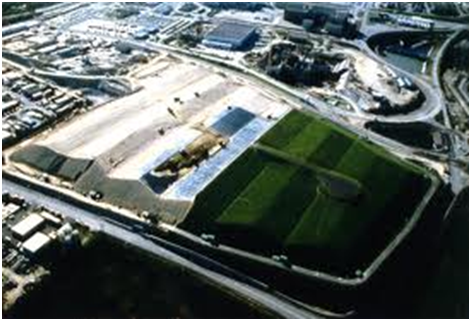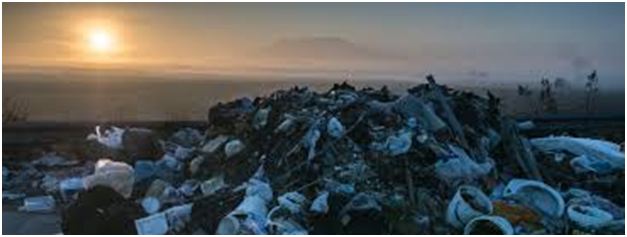
Blog
-
Geiger Readings for February 8, 2013
Ambient office = 119 nanosieverts per hourAmbient outside = 93 nanosieverts per hourSoil exposed to rain water = 83 nanosieverts per hourIceberg lettuce from Top Foods = 83 nanosieverts per hourTap water = 116 nanosieverts per hourFiltered water = 85 nanosieverts per hourAlaskan Copper River Salmon = 88 nanosieverts per hour -
Radioactive Waste 54 – Illegal Nulcear Waste Dumping in France
My last couple of blog entries have been about illegal dumping of radioactive waste by the Mafia in Italy. I decided to open this discussions to other countries in Europe. Today I am going to blog about illegal dumping in France. French law states clearly that it is not legal to bring nuclear wastes from other countries into French nuclear dump sites.
The Manche Center for Storage is one of Europe’s biggest storage sites for radioactive waste. It located in a wetland near the nuclear reprocessing plant at La Hague in Normandy, France. It was commissioned in 1967 and the first waste arrived in 1969. At first, the waste was stored in trenches dug into the ground. Later concrete blocks were placed around the barrels of waste which were then covered by a plastic sheet and buried with dirt.
In the early 1970s, the Center began receiving and storing spent nuclear fuel and other nuclear wastes from French nuclear power plants. In 1976, heavy rainfall, overflow of drainage ditches and a faulty pump caused the contamination of ground water with tritium. In 1984, the concrete walls were added to the containment trenches and other upgrades were made to the site. In 1991, a cover was constructed over the site to prevent water from getting to the waste.
In 1994, the last package of waste was received and the site reached saturation. The site was closed and management of the site was turned over to the National Agency for Radioactive Waste Management (ANDRA). About one and one half million packages of waste are stored at the site.
In 2006, Greenpeace activists demonstrated at Manche. They had come from the Netherlands, Switzerland, Belgium, Japan to protest the storage of nuclear waste from their countries at Manche in clear violation of French law. They claimed that there were one hundred and forty thousand containers of nuclear waste at the site that had not originated in France. The protesters were demanding that all the containers at the site including those from France be dug up and repackaged.
Greenpeace provided a study dealing with radioactive contamination of the ground water and the surface streams around the site. In addition to the tritium leak in 1976, an engineer from the Manche site stated that other radioactive materials in the dump including plutonium will eventually leak out of the dump and threaten the dairy farms around the dump. Greenpeace did win a court victory when ANDRA was found guilty in a French court of illegally storing nuclear waste from Australia. Greenpeace has also attacked ANDRA over the reprocessing of Dutch nuclear spent fuel in the nearby reprocessing plant at La Hague.
Unfortunately, the French authorities do not even have a complete record of what is stored at Manche. Documents at the site were destroyed in two floods and substitute fake documents were created to replace them. This nuclear waste site is a time bomb ticking away in the French countryside. It is an illustration of the illegal inclusion of nuclear waste in a major national nuclear dump. Even government agencies cannot be trusted to deal properly with nuclear waste.
Manche Center for Storage:
-
Radiation News Roundup February 7, 2013
The radiation dose on the “stand” above Fukushima Unit 4 spent fuel pool is 90 μSv/h, according to NRA. Fukushima-diary.com
Eight more Fukushima children have been confirmed as having thyroid gland cancer. Japantimes.co.jp
NRA tells TEPCO to reduce radiation exposure at Fukushima plant. Ajw.asahi.com
The Waste Isolation Pilot Plant in New Mexico has temporarily stopped accepting waste but remained secure following a fire underground. Nuclearstreet.com
-
Geiger Readings for February 7, 2013
Ambient office = 116 nanosieverts per hourAmbient outside = 85 nanosieverts per hourSoil exposed to rain water = 106 nanosieverts per hourRomaine lettuce from Top Foods = 91 nanosieverts per hourTap water = 104 nanosieverts per hourFiltered water = 96 nanosieverts per hour -
Radioactive Waste 53 – Illegal Nuclear Waste Dumping in Italy 2
My last post was about how the Mafia in Italy was illegally dumping toxic waste including radioactive materials. I focused mainly on the Camorra Mafia in Campania, a southern state of Italy. I briefly mentioned the ‘Ndrangheta Mafia in Calabria, a state in the toe of the Italian “boot.” Today, I am going to delve deeper into the ‘Ndrangheta and the international dumping that is going on. Strict environmental regulations introduced in the 1980s increased the profits for Italian Mafias engaged in illegal dumping.
A damning report issued by the Italian parliament in 1995 suggested widespread institutional support for such illegal dumping. The report found evidence of national and international trafficking in radioactive waste. Businesses and political lobbying groups were operating with the full support some agencies within governments that were members of the European Union as well as governments outside of the Union. The investigators who put the report together experienced threats and interference in their research from individuals within government agencies.
The Italian Ente Nazionale per l’Energia Atomica or ENEA (National Agency for Atomic Energy) is the another national nuclear agency that is charged with both promoting the Italian nuclear industry and protecting the environment. As in many other cases, there have been repeated charges that the ENEA is a little too friendly with the nuclear industry that it is suppose to regulate and a little too lax in the enforcement of environmental regulations.
In 2005, an former member of the ‘Ndrangheta published claims in an Italian magazine that the ‘Ndrangheta had deliberately sunk at least thirty ships including some that were carrying radioactive waste. The magazine article triggered serious investigation of radioactive waste handling. Legitimate waste disposal firms were swept up in the investigation. Over a period of two decades, there have been over thirty questionable sinking of ships in the Mediterranean Sea. Sometimes ships with suspicious cargos sank in fair weather with no signal for help. Often, the crews just vanished.
The informant claimed that a manager with the ENEA paid the ‘Ndrangheta to dispose of six hundred drums of toxic and radioactive waste that originated in Italy, Switzerland, France, Germany and the United States. The ship carrying the waste was sent to Somalia where the waste was buried after the local officials were bought off. Other employees of ENEA are suspected of paying off the Mafia during the 1980s and 1990s to dump toxic and radioactive wastes. There were also charges that prominent politicians with ties to major Italian political parties were involved in the illegal dumping schemes and made use of the Italian secret service to hide their activities.
Once again, I have to emphasize that even if it is possible to build safe nuclear reactors and to fuel them and dispose of waste without ecological damage, the problems outlined in this blog indicate that crime syndicates, industries and government agencies often collaborate to skirt nuclear regulations.
Italian Calabrian coast:
-
Geiger Readings for February 6, 2013
Ambient office = 92 nanosieverts per hourAmbient outside = 111 nanosieverts per hourSoil exposed to rain water = 110 nanosieverts per hourVine ripened tomato from Top Foods = 120 nanosieverts per hourTap water = 119 nanosieverts per hourFiltered water = 95 nanosieverts per hour -
Radiation News Roundup February 5, 2013
Former Japan Prime Minister says that Alaskan Seals and polar bears are dying after Fukushima radiation exposure. enenews.com
Scientists have found nuclear waste off San Diego coast. enenews.com
US production of uranium concentrate increased 16% in 2013, reaching its highest level since 1997, according to preliminary figures. world-nuclear-news.org
-
Radioactive Waste 52 – Illegal Nuclear Waste Dumping in Italy 1
In 1980, the Camorra Mafia took over the garbage removal in the Italian state of Campania. At the same time, the ‘Ndrangheta Mafia moved into the garbage business in Calabria, another southern Italian state. The Mafia is drawn to garbage collection because ” It’s easy to infiltrate, it’s a desperate necessity for every citizen, and it’s not terribly hard to do.” Organized crime all over the world is in the garbage business.
Campania has been called the “Land of Fires” because there are frequent garbage fires. Desperate landowners are willing to sell off their land cheap to Mafia clans looking for dump sites. It is as if the entire state is seen as a “gigantic carpet” that anything can be swept under. In some places, the land has become so unstable from dumping that houses and other buildings have to be supported by concrete scaffolds. It has been estimated that as much as ten million tons of toxic and nuclear waste have been dumped in Campania. Some of the waste is transported from as far away as Germany.
There is a severe toll on public health from the toxic and nuclear waste. In some area, the rate of cancer is as much as fifty percent higher than the national average. This toll on health has earned Campania another nickname: “The Triangle of Death.” Studies have shown that much of the water in Campania is not safe to drink because of the waste running off the land into streams and rivers. It is difficult to understand how someone could do such damage to the land they live in. The lifespan of a Mafia boss is short and often ends in violence. This leads to an attitude of “live for today” without much concern for the future that the mafia is destroying. They have been referred to as the eco-Mafia. The national government has mobilized the army and is using drones to locate dumpsites.
Mafia dumping has spread beyond Italy to Somalia. There have been reports of deals where guns are traded for the opportunity to dump wastes. Hundreds of barrels of waste have shown up on the shore of Somalia including radioactive uranium waste as well as heavy metals and other toxic substances. A hidden network has sprung up around the world to move toxic and nuclear waste from the developed world to the poor and desperate developing world. A lot of attention in the nuclear nations is paid to the safe disposal of nuclear waste. This global dumping conspiracy threatens to make a joke out of such concern.
Illegal toxic waste dumping in Italy:
-
Geiger Readings for February 5, 2013
Ambient office = 77 nanosieverts per hourAmbient outside = 82 nanosieverts per hourSoil exposed to rain water = 87 nanosieverts per hourCrimini mushroom from Top Foods = 100 nanosieverts per hourTap water = 109 nanosieverts per hourFiltered water = 86 nanosieverts per hour






